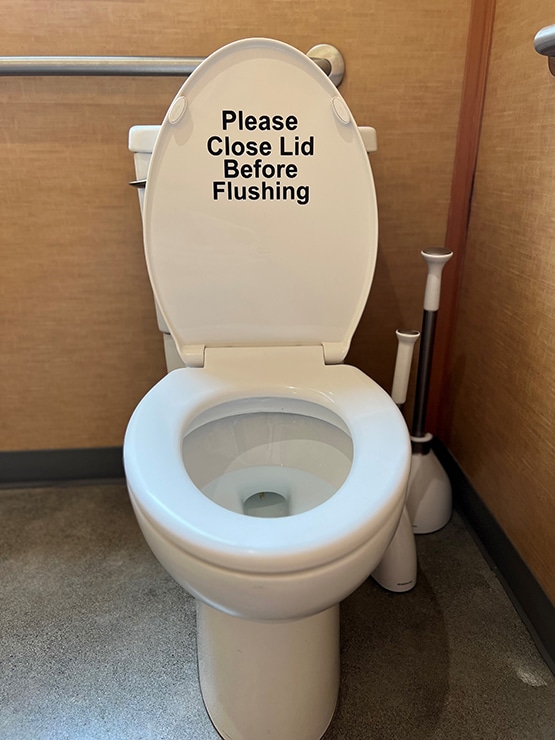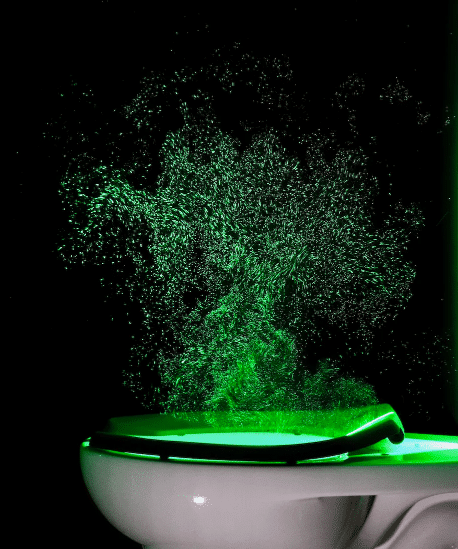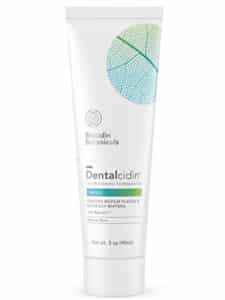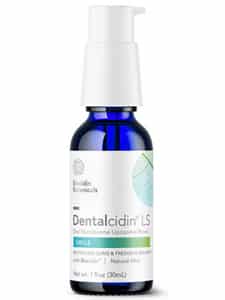
Did You Know
- Your body sheds approximately 600,000 skin cells per day (that 1.5 pounds a year)
- Your shedding skin contributes to 69-88% of the dust around you.
- Your body sheds 50 billion microbial debris every few hours.
- Close the toilet when you flush – or stool microbes will build up on surfaces, including E. coli.
I truly cherish the ongoing opportunities in my career to continue learning, researching, and the evolution of my understanding of the human body. Admittedly, there are moments when the knowledge I acquire drives me a bit over the edge and prompts me to adjust my habits (much to the amusement of my family, I’m sure).
Here’s a prime example: “Please close the toilet lid before flushing.”
If I could, I’d have this message engraved on the inner side of every toilet lid. The apprehension I feel while entering stadium restrooms devoid of lids and equipped with auto-flush systems is real; it often translates into a damp bottom encounter for the unsuspecting user AND it means that trillions upon trillions of bacteria are coating every surface in that bathroom (and, stool bacteria has aerosolized into the air).
It’s long been understood that everywhere we go, our body leaves a trail of shedding skin cells. Humans shed about 600,000 skin cells per day and up to 1.5 pounds of skin cells per year. Research from the Journal of Allergy and Clinical Immunology found that shedding skin contributes to 69 to 88 percent of dust in our homes [1].
In the hustle of daily life, we rarely stop to consider the invisible particles that are released into the air from our body – both cells (from our skin shedding) and microbes. Think for a moment, about Pigpen from the Peanuts and the cloud of dust surrounding him everywhere he walked. Now, turn this into a cloud of cells and microbes – this is your microscopic cloud that you take with you everywhere you go. Your body interacts and acquires microbes from the people, pets and environment that is around you. In this article, we explore the mechanisms behind this bacterial dissemination, the potential harm to human health, and why keeping stool bacteria away from our mouths and noses is crucial.

Actual aerosolization of water and bacteria when toilet is flushed.
Aerosolized Bacteria: The Hidden Fallout
Surprisingly, every time we flush, a microscopic storm of bacteria-laden aerosols is unleashed, traveling far beyond the confines of the bathroom. This silent but impactful event raises concerns about potential health risks as these bacteria settle on surfaces, including toothbrushes.
The mechanism responsible for the spread of bacteria begins innocently enough with the powerful force generated by the flushing water. As the toilet is flushed, a swirling vortex of water creates a turbulent mixture that propels tiny water droplets into the air. These droplets, infused with the invisible microbes residing in the toilet bowl, form an aerosol cloud that can reach surprising heights and distances.
Studies have shown that this aerosol cloud contains a variety of microorganisms, including fecal bacteria like Escherichia coli (E. coli) and other potentially harmful pathogens [2]. These bacteria can remain suspended in the air for a brief period, and as they settle, they coat nearby surfaces with a microbial layer that often goes unnoticed.
Contaminated Surfaces: Toothbrushes and Beyond
As the aerosol settles, it leaves behind a bacterial residue on surfaces within the bathroom, ranging from countertops to towels. One of the most concerning surfaces is the toothbrush. Toothbrushes, often stored openly in bathrooms, can become hosts to a variety of bacteria, including those originating from fecal matter. This microbial transfer from the toilet to toothbrush is particularly alarming due to the potential implications for oral and overall health.
One study demonstrated that aerosols generated by flushing toilets could disperse potentially infectious microbes throughout the bathroom environment [3]. Another study highlighted that aerosolized particles from toilet flushes can travel significant distances and could potentially contribute to the transmission of infectious agents [4].
Health Hazards: When Stool Bacteria Meets the Mouth
The introduction of stool bacteria into our oral and nasal cavities poses more than just a hygiene concern. The oral cavity, known for its complex ecosystem of bacteria, is highly sensitive to microbial imbalances. Introducing stool bacteria into this environment can disrupt the delicate balance, potentially leading to oral infections, bad breath, and gum disease [5]. Furthermore, the potential for the transfer of pathogenic bacteria raises concerns about the risk of gastrointestinal infections, especially in individuals with compromised immune systems or pre-existing health conditions.
In addition to the oral cavity, the nasal passages are equally susceptible to harm from aerosolized bacteria. The nasal mucosa, acting as a first line of defense against pathogens, can become compromised if exposed to potentially harmful bacteria. This can lead to increased susceptibility to respiratory infections and inflammation[6].
Treating the Oral Microbiome
Dental health is a cornerstone of overall well-being, and products like Dentalcidin Toothpaste and Rinse have emerged as innovative solutions for maintaining oral hygiene. Developed by Biocidin Botanicalsproducts, Dentalcidin Toothpaste and Rinse are designed to offer a comprehensive approach to oral care. I regularly use and highly recommend both of these products for maintaining oral health.
 |
Dentalcidin Toothpaste Dentalcidin Toothpaste is not your ordinary toothpaste. It combines the power of Biocidin’s proprietary blend of botanicals with oral probiotics to promote a healthy oral microbiome. This toothpaste is free from harmful ingredients like fluoride, sodium lauryl sulfate, and artificial preservatives, making it a gentle yet effective option for daily dental care. It’s particularly beneficial for those seeking a natural alternative for oral health support. |
 |
Dentalcidin LS Oral Care Complementing the toothpaste, Dentalcidin LS Oral Care offers an extra layer of oral hygiene. It incorporates the same botanical and probiotic blend to support a balanced oral microbiome. LS Oral Care breaks up biofilms and plaque and helps balance oral microbes |
Mitigation and Prevention
To mitigate the risks associated with bacterial aerosols and their contamination of surfaces, it is imperative to adopt hygienic practices. Closing the toilet lid before flushing can significantly reduce the release of aerosols into the air. Regular cleaning and disinfection of bathroom surfaces, especially those in close proximity to the toilet, can help minimize the microbial load. Toothbrushes should be stored in a clean, dry environment, away from the direct path of the aerosol fallout.
Moreover, being vigilant about hand hygiene and avoiding the transfer of stool bacteria to the mouth and nose is crucial. Washing hands thoroughly after using the toilet and before handling food or touching the face can help prevent the spread of harmful bacteria.
An Unseen Battle
The seemingly innocuous act of flushing the toilet unveils a battle between bacteria and our hygiene practices. The aerosols released during flushing may be invisible, but their effects on our health are far from negligible. By understanding the mechanisms at play and adopting proactive hygiene measures, we can minimize the risk of bacterial contamination in our surroundings and preserve the well-being of our oral and respiratory health.
- Täubel M, Rintala H, Pitkäranta M, Paulin L, Laitinen S, Pekkanen J, Hyvärinen A, Nevalainen A. The occupant as a source of house dust bacteria. J Allergy Clin Immunol. 2009 Oct;124(4):834-40.e47. doi: 10.1016/j.jaci.2009.07.045. Epub 2009 Sep 19. PMID: 19767077.
- Barker, J., & Jones, M. V. (2005). The potential spread of infection caused by aerosol contamination of surfaces after flushing a domestic toilet. *Journal of Applied Microbiology*, 99(2), 339-347.
- Gerba, C. P., Wallis, C., & Melnick, J. L. (1975). Microbiological hazards of household toilets: Droplet production and the fate of residual organisms. Applied and Environmental Microbiology, 30(2), 229-237.
- Best, E. L., Sandoe, J. A. T., Wilcox, M. H. (2012). Potential for aerosolization of Clostridium difficile after flushing toilets: The role of toilet lids in reducing environmental contamination risk. American Journal of Infection Control, 40(10), 907-909.
- Marsh, P. D. (2006). Dental plaque as a biofilm and a microbial community—implications for health and disease. *BMC Oral Health*, 6(1), S14.
- Sasidharan A, et al. (2016). Understanding the nose-lung interaction in allergic rhinitis and asthma. *Asia Pac Allergy*, 6(1):3-10.
Enjoying this content? Sign up for updates... It's FREE!


